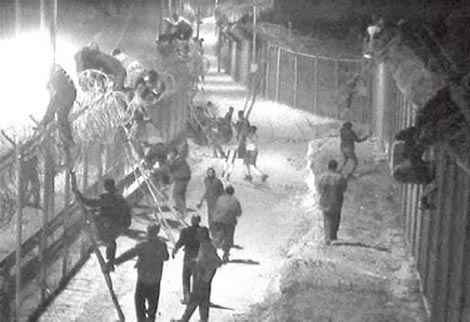Immigration Policy a Casualty of Unemployment in Spain
 As the once-vibrant Spanish economy plunges deeper into recession, the government of Socialist Prime Minister José Luis Rodríguez Zapatero is struggling to staunch the country’s skyrocketing jobless rate. And among the first casualties is Spain’s famously lenient immigration policy.
As the once-vibrant Spanish economy plunges deeper into recession, the government of Socialist Prime Minister José Luis Rodríguez Zapatero is struggling to staunch the country’s skyrocketing jobless rate. And among the first casualties is Spain’s famously lenient immigration policy.
With employers shedding jobs at a record pace, Spain’s unemployment rate has nearly doubled over the past year to 17.4 percent, the highest in the European Union. More than 4 million Spanish workers are now unemployed, and that number is expected to reach 5 million by 2010. One million Spanish families now have no source of income, and unemployment benefits, which last for a maximum of two years, will run out for millions more in the near future. All of this has the government worried about the potential for social unrest in Spain.
Although the jobless numbers are staggering, the official unemployment data reveals that the problems are being borne unevenly. The majority of those affected by layoffs in Spain are temporary and self-employed workers, 800,000 of whom lost their jobs in the first quarter of 2009. Many of these jobs losses involve immigrants and the construction sector.
Until the recent slowdown, Spain was one of the fastest-growing economies in Europe. In the decade to 2007, for example, real growth ran at an annual average of more than 3.5 percent, compared with 2.0 percent for the rest of Europe. The main driver of this expansion was the housing industry. At its peak in 2006, Spain built upwards of 750,000 new homes, more than the rest of Europe combined. The construction boom was fuelled by enormous increases in house prices: At the end of 2007, real estate prices in Spain were almost 200 percent higher than they were in 1997.
But rising interest rates, the global credit crunch and oversupply is now forcing a painful correction of the Spanish housing market. This, in turn, is causing a rapid deceleration of the Spanish economy and a corresponding rise in unemployment. Construction — which by some estimates accounted for up to 10 percent of Spanish GDP in 2006, twice the level of other eurozone countries — is now grinding to a halt. The number of new housing starts in Spain is expected to drop to less than 150,000 in 2009, down 40 percent from 2008, and the lowest level since 1960. As a result, construction jobs are disappearing at a rapid clip, and immigrants seem to be affected the most.
Spain’s real estate boom, which helped to create more than 5 million new jobs, was supported by cheap labor, largely supplied by immigrants from Latin America, Eastern Europe and North Africa. More than 920,000 new immigrants arrived in Spain during 2007, according to the latest data published by the Spanish National Statistics Institute (INE). This was on top of the 802,971 new arrivals in 2006, the 682,711 new arrivals in 2005, and the 645,844 new arrivals in 2004. Spain now has a total of 5.2 million immigrants, more than 10 percent of its population, which has swelled from 40 million in 2000 to just over 46 million in 2009.
According to the Fundación BBVA research institute, Spain now has the second-largest number of immigrants as a proportion of the population in the developed world, after the United States. But immigrants are now losing their jobs at more than twice the rate of Spaniards, raising fears that they will turn to crime.
To ward off social tensions, the Spanish government is now rethinking its immigration policy. In 2005, Zapatero angered other European leaders by giving a blanket amnesty to 800,000 illegal immigrants. By contrast, he now supports the European Union’s Return Directive for undocumented workers. His government also wants to restrict family immigration to parents and their children under 18. The law currently allows grandparents and in-laws to join their families.
In July 2008, the Spanish government launched a scheme to pay unemployed migrant workers to return to their country of origin. The plan offers documented migrants who have lost their jobs two lump sums, one before they leave Spain and the other once they have returned home. In exchange, immigrants are required to hand over their residence visas and work permits and agree not to return to Spain for at least three years. But so far there have been only around 4,000 takers, a tiny fraction of Spain’s immigrant population.
Spain now seems to be turning to more draconian measures. Police in major Spanish cities like Madrid and Barcelona have been given weekly quotas for arresting illegal immigrants. According to a leaked internal memo, police in Madrid have a weekly target of 35 arrests, with priority given to seizing Moroccans because they could be sent home quickly and cheaply.
The problem of runaway immigration was a major issue during Spain’s 2008 general election. Toward the end of the campaign, the race turned decisively in Zapatero’s favor after his main opponent called for a crackdown on illegal immigration. At the time, Zapatero said the proposals were inhumane and many Spanish voters seemed to agree. But Zapatero’s recent about-face suggests that Spanish society is now unifying around the idea that runaway immigration must be curbed.
Published by World Politics Review on May 13, 2009
Soeren Kern is Senior Fellow for Transatlantic Relations at the Madrid-based Grupo de Estudios Estratégicos / Strategic Studies Group



